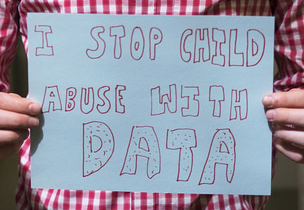 Collecting and using data is one of the ways we improve our programs to help families and children. As one of two Data Managers at the Prevention Center, I have had the privilege of working closely with our staff who support families, empower children, and educate our community. Many of our findings are very positive — for example, more than 75% of families who are at high-risk for child abuse who receive individualized services, demonstrate improvement in family functioning after working with us for at least three months. However, analyzing our data also raised some good questions:
Collecting and using data is one of the ways we improve our programs to help families and children. As one of two Data Managers at the Prevention Center, I have had the privilege of working closely with our staff who support families, empower children, and educate our community. Many of our findings are very positive — for example, more than 75% of families who are at high-risk for child abuse who receive individualized services, demonstrate improvement in family functioning after working with us for at least three months. However, analyzing our data also raised some good questions:
Although we don’t yet have an answer to these specific questions, asking and answering these types of questions wouldn’t be possible without a solid foundation of data collection. In the process of serving clients, we collect three categories of information:
(It’s important to note, client confidentiality is always front and center to our work.)
DEMOGRAPHICS
Understanding our client demographics (age, zip code, ethnicity, gender, monthly income, health insurance, etc.) helps us learn whether those we’re serving represent the population of San Francisco families as a whole.
ASSESSMENTS
Assessment tools refer to the array of surveys we use to gauge client satisfaction and changes in knowledge, attitudes, and behavior. The tools and the frequency with which we use them varies depending on the program. For most of our educational groups, we administer pre- and post-tests. For individual services such as counseling, case management, and one-on-one parent education, case managers work with our families to assess progress every 90 days using tools like the North Carolina Family Assessment Scale. Clinicians use these results to decide which approaches are right for each client, and to track clients’ progress over time.
In addition, team members review the results of these assessments on a monthly basis to understand how well our services are working for clients in general, and to target areas for improvement.
INTERACTION
Finally, interaction data includes the information we record for each service our clients receive. Each counseling session, visit to a group, and call to the TALKLine is recorded in our database. For every service we know the date, the client served, the staff member providing service, the amount of time spent, and notes on the interaction.
In addition, for our individual services we ask our clinicians to answer specific questions about the client that align with the outcomes of the program. For example, every time a child receives play therapy, we gauge whether the child demonstrates awareness of him/herself. These “Short Term Indicators” help us understand who may or may not be making progress in between when the family is rated via a more comprehensive assessment tool.
THE SUM
All of this data adds up. For example, we provide high intensive services to 50 families at any given time. Among these families, that totals around 150 caregivers and children. We collect 15 demographic categories for each participant. If we assess families every 90 days using both a client-completed survey and a clinician-completed survey, and most families engage with us for roughly two years, we may have up to 18 assessments per family, hundreds of demographic data points, and thousands of records of individual service.
Currently, we have around 30,000 data-points around clients receiving one-on-one services alone, and this number will only keep growing. Collecting this information about our services has been a huge investment in time, but it’s paying off.